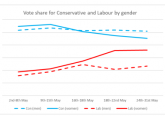
The conventional wisdom about US presidential campaigns is that they are dominated by two highly sophisticated political machines. Both campaign teams are stocked full of bright, hard-working staff and volunteers. The Democrats and Republicans each wield increasingly complex software packed full of voter information, opinions and support. As Rasmus Kleis Nielsen recently wrote on this blog campaigns are central to the outcome of the election. You would think, then, that the parties would have a pretty good idea of what sort of person is likely to vote for them. A recent book suggest that the Democrats have developed highly complex ways of figuring this out. On the other hand, given two recent events, I’m not sure the Republicans have any idea.
Coverage of the US Presidential election last week was dominated by the now notorious video in which Mitt Romney declared that:
There are 47 percent of the people who will vote for the president no matter what. All right, there are 47 percent who are with him, who are dependent upon government, who believe that they are victims, who believe the government has a responsibility to care for them, who believe that they are entitled to health care, to food, to housing, to you-name-it. That that’s an entitlement. And the government should give it to them. And they will vote for this president no matter what…These are people who pay no income tax.
Predictably Romney was excoriated for his comments. Commentators have focused on the inaccurate representation of the ‘47%’ and, as the Obama campaign has put it, that he has written off half the country. Less attention has been given to the fact that his comments suggest that Romney has no idea who his voters actually are. As Bryan Caplan, author of The Myth of the Rational Voter, points out in a recent blog, Romney’s comments suggest that he believes in the (false) self-interested voter hypothesis: voter’s will make rational voting decisions based on which candidate will benefit them personally – poor people will vote for Obama and rich people will vote for Romney.
The real story, as data from the American National Election Study clearly demonstrates, is much more complicated. Using panel data from the last election, it is true that Republican voters are, on average, richer than Democrats. However, only slightly: the median Republican voter earned between $60,000 and $74,999, whilst the median Democrat earned $50,000 to $59,000 (for reference the median income in the US in 2008 was $52,029). As the graph below illustrates, the distribution of voters by income is actually very similar for both parties, and around 40% of Republican voters in the last election earned less than the median income, making them excellent candidates for inclusion among the 47% who Romney claims pay no income tax. Clearly though he is well wide of the mark if he believes that these are people who will vote for Obama ‘no matter what’.
Does Romney actually believe that almost none of the poorest half of Americans will vote for him? His comments were almost certainly designed to flatter his wealthy prospective donors and so we should take them with a grain of salt. However, other news this week suggests that maybe Republicans really don’t know who votes for which candidate. Faced with an onslaught of polls all showing a large Obama lead, the Republican Party declared that all of the polls were rigged against them because they included to many Democrats, criticism roundly dismissed by non-partisan pollsters. Again it is questionable whether Republicans campaigners genuinely don’t understand survey methodology or they are simply trying to spin bad news: the prevailing wisdom in US politics being that if you poll badly, your campaign donations dry up. Given the events of the last two weeks, I imagine Republican donors are less concerned with the polling numbers and more concerned with the impression the Republican campaign is giving of being completely inept, particularly in light of the revelation that Romney’s staffers are paid more to achieve less than their Democrat counterparts (though Rachel Maddow shared an amusing story this week suggesting that wealthy Republicans had no problem throwing money at a sinking ship [skip to the 2 minute mark]).
Even if he was wrong about who they are, Romney was almost correct about one thing: A large proportion of the US electorate would probably vote for Obama regardless of what happens in the campaign (though its slightly less than 47%). Voting for a candidate ‘no matter what’ is hard to quantify but a good proxy is to compare though distinguish between ‘swing’ voters, who might potentially vote for either candidate, and ‘base’ voters, who would only vote for one. In research published in 2007 William Mayer estimated that at Presidential elections from 1992 to 2004 the average proportion of the electorate that can be considered the Democrat ‘base’ was 42%. Rupert Cornwall recently asked if Romney was the most inept candidate for the Presidency ever, which given recent events is not an unreasonable question. Fortunately for the Republican Party the size of the Republican base is very similar. ‘No matter what’ the Romney campaign manages to mangle in the last few weeks of the campaign more than 40% of the electorate will still vote for him, which on campaign competence alone is much more than he deserves.
Chris Prosser is a DPhil Student in Politics at St Catherine’s College, Oxford.








1 Comment